Olympus America (microscopy/Imaging)
MICROSCOPY RESOURCES
BASIC PROCEDURES, Tutorials, Olympus Manuals
Molecular Expressions (FSU) (Great pictures, Primers...)
Download Old Olympus Microscope Catalogues and instruction Manuals
LINKS TO MICROSCOPY SOURCES
MICROSCOPY BOOKS
(Links are to publisher online (if available) or printed version of the book. Some links might be dead (Page is update sporadically).
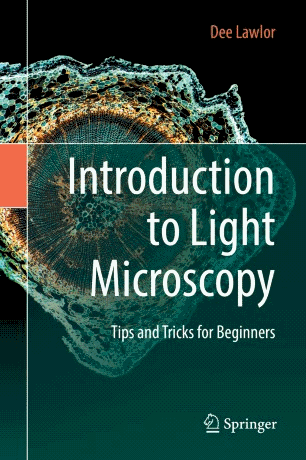
Introduction to Light Microscopy. Tips and Tricks for Beginners (2019)
Dee LawlorSpringer
ISBN 978-3-030-05392-5
164 pagesPublisher Description: This book offers a beginner’s guide to using light microscopes. It begins with a brief introduction to the physics of optics, which will give the reader a basic grasp of the behaviors of light. In turn, each part of the microscope is explained using clear and simple English, together withdetailed photographs and diagrams. The reader will learn the function, care and correct use of each part. A troubleshooting section also helps resolve some of the most common issues encountered in light microscopy. Most people have a general idea of how to use a microscope, but many never get the full benefit, because they receive no training. With easy-to-follow steps and detailed images, this guide will help everyone achieve the best results, and be confident using their microscope. This book is intended for anyone using a light microscope, such as university students, people in lab environments, hobbyists, educators who teach science to young children, and anyone with a general interest in these valuable tools.
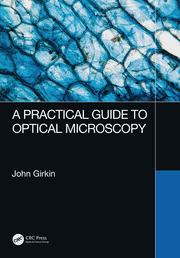
John Girkin
CRC Press
ISBN
278 pagesPublisher Description: Optical microscopy is used in a vast range of applications ranging from materials engineering to in vivo observations and clinical diagnosis, and thanks to the latest advances in technology, there has been a rapid growth in the number of methods available. This book is aimed at providing users with a practical guide to help them select, and then use, the most suitable method for their application. It explores the principles behind the different forms of optical microscopy, without the use of complex maths, to provide an understanding to help the reader utilise a specific method and then interpret the results. Detailed physics is provided in boxed sections, which can be bypassed by the non-specialist. It is an invaluable tool for use within research groups and laboratories in the life and physical sciences, acting as a first source for practical information to guide less experienced users (or those new to a particular methodology) on the range of techniques available.
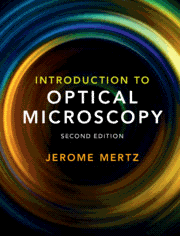
Introduction to Optical Microscopy (2019)
J
erome MertzCambridge Press
ISBN 9781108428309 462 pages
Publisher Description: This fully updated, self-contained textbook covering modern optical microscopy equips students with a solid understanding of the theory underlying a range of advanced techniques. Two new chapters cover pump-probe techniques, and imaging in scattering media, and additional material throughout covers light-sheet microscopy, image scanning microscopy, and much more. An array of practical techniques are discussed, from classical phase contrast and confocal microscopy, to holographic, structured illumination, multi-photon, and coherent Raman microscopy, and optical coherence tomography. Fundamental topics are also covered, including Fourier optics, partial coherence, 3D imaging theory, statistical optics, and the physics of scattering and fluorescence. With a wealth of end-of-chapter problems, and a solutions manual for instructors available online, this is an invaluable book for electrical engineering, biomedical engineering, and physics students taking graduate courses on optical microscopy, as well as advanced undergraduates, professionals, and researchers looking for an accessible introduction to the field.
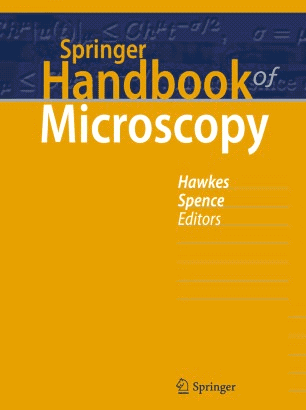
Springer Handbook of Microscopy (2019)
Peter W. HawkesJohn C. H. Spence (Eds.)
Springer
ISBN 978-3-030-00068-41
1543 pagesPublisher Description: This book features reviews by leading experts on the methods and applications of modern forms of microscopy. The recent awards of Nobel Prizes awarded for super-resolution optical microscopy and cryo-electron microscopy have demonstrated the rich scientific opportunities for research in novel microscopies. Earlier Nobel Prizes for electron microscopy (the instrument itself and applications to biology), scanning probe microscopy and holography are a reminder of the central role of microscopy in modern science, from the study of nanostructures in materials science, physics and chemistry to structural biology. Separate chapters are devoted to confocal, fluorescent and related novel optical microscopies, coherent diffractive imaging, scanning probe microscopy, transmission electron microscopy in all its modes from aberration corrected and analytical to in-situ and time-resolved, low energy electron microscopy, photoelectron microscopy, cryo-electron microscopy in biology, and also ion microscopy. In addition to serving as an essential reference for researchers and teachers in the fields such as materials science, condensed matter physics, solid-state chemistry, structural biology and the molecular sciences generally, the Springer Handbook of Microscopy is a unified, coherent and pedagogically attractive text for advanced students who need an authoritative yet accessible guide to the science and practice of microscopy.
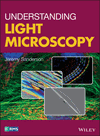
Understanding Light Microscopy (2019)
Jeremy Sanderson
Wiley
ISBN 9780470973752
817 pagesPublisher Description: Introduces readers to the enlightening world of the modern light microscope. There have been rapid advances in science and technology over the last decade, and the light microscope, together with the information that it gives about the image, has changed too. Yet the fundamental principles of setting up and using a microscope rests upon unchanging physical principles that have been understood for years. This informative, practical, full-colour guide fills the gap between specialised edited texts on detailed research topics, and introductory books, which concentrate on an optical approach to the light microscope. It also provides comprehensive coverage of confocal microscopy, which has revolutionised light microscopy over the last few decades. Written to help the reader understand, set up, and use the often very expensive and complex modern research light microscope properly, Understanding Light Microscopy keeps mathematical formulae to a minimum—containing and explaining them within boxes in the text. Chapters provide in-depth coverage of basic microscope optics and design; ergonomics; illumination; diffraction and image formation; reflected-light, polarised-light, and fluorescence microscopy; deconvolution; TIRF microscopy; FRAP & FRET; super-resolution techniques; biological and materials specimen preparation; and more.
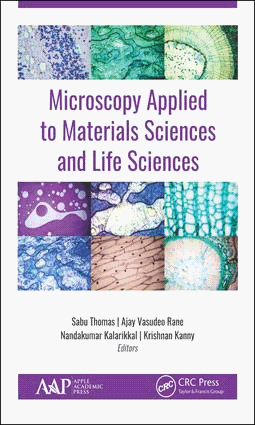
Microscopy Applied to Materials Sciences and Life Sciences (2018)
Ajay Vasudeo Rane, Sabu Thomas, Nandakumar Kalarikkal (Eds.)
CRC Press
ISBN
526 pagesPublisher Description: This new volume, Microscopy Applied to Materials Sciences and Life Sciences. focuses on recent theoretical and practical advances in polymers and their blends, composites, and nanocomposites related to their microscopic characterization. It highlights recent accomplishments and trends in the field of polymer nanocomposites and filled polymers related to microstructural characterization. This book gives an insight and better understanding into the development in microscopy as a tool for characterization. The book emphasizes recent research work in the field of microscopy in life sciences and materials sciences mainly related to its synthesis, characterizations, and applications. The book explains the application of microscopic techniques in life sciences and materials sciences, and their applications and state of current research carried out. The book aims to foster a better understanding of the properties of polymer composites by describing new techniques to measure microstructure property relationships and by utilizing techniques and expertise developed in the conventional filled polymer composites. Characterization techniques, particularly microstructural characterization, have proven to be extremely difficult because of the range of length-scales associated with these materials.

W. P. Gray (Jay) Jerome, Robert L. Price (Eds.)
Springer
ISBN
978-3-319-97453-8 368 pagesPublisher Description: Basic Confocal Microscopy, Second Edition builds on the successful first edition by keeping the same format and reflecting relevant changes and recent developments in this still-burgeoning field. This format is based on the Confocal Microscopy Workshop that has been taught by several of the authors for nearly 20 years and remains a popular workshop for gaining basic skills in confocal microscopy. While much of the information concerning fluorescence and confocal microscopy that made the first edition a success has not changed in the six years since the book was first published, confocal imaging is an evolving field and recent advances in detector technology, operating software, tissue preparation and clearing, image analysis, and more have been updated to reflect this. Several of these advances are now considered routine in many laboratories, and others such as super resolution techniques built on confocal technology are becoming widely available.
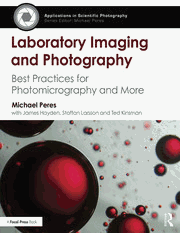
Laboratory Imaging & Photography. Best Practices for Photomicrography and More (2017)
Michael Peres
Routledge
ISBN
392 pagesPublisher Description: Laboratory Imaging and Photography: Best Practices for Photomicrography and More is the definitive guide to the production of scientific images. Inside, the reader will find an overview of the theory and practice of laboratory photography, along with useful approaches to choosing equipment, handling samples, and working with microscopic subjects. Drawing from over 150 years of combined experience in the field, the authors outline methods of properly capturing, processing and archiving the images that are essential to scientific research. Also included are chapters on applied close-up photography, artificial light photography and the optics used in today’s laboratory environment, with detailed entries on light, confocal and scanning electron microscopy. A lab manual for the digital era, this peerless reference book explains how to record visual data accurately in an industry where a photograph can serve to establish a scientific fact.
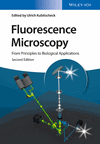
Fluorescence Microscopy. From Principles to Biological Applications. 2nd Ed. (2017)
Ulrich Kubitscheck
(Ed.)Wiley
ISBN 9783527338375
482 pagesPublisher Description: While there are many publications on the topic written by experts for experts, this text is specifically designed to allow advanced students and researchers with no background in physics to comprehend novel fluorescence microscopy techniques. This second edition features new chapters and a subsequent focus on super-resolution and single-molecule microscopy as well as an expanded introduction. Each chapter is written by a renowned expert in the field, and has been thoroughly revised to reflect the developments in recent years.
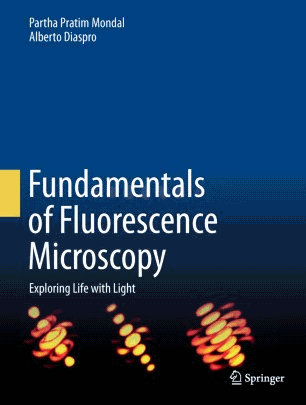
Fundamentals of Fluorescence Microscopy. Exploring Life with Light (2014)
Partha Pratim Mondal, Alberto Diaspro
Springer
ISBN 978-94-007-7544-2 218 pages
Publisher Description: This book starts at an introductory level and leads reader to the most advanced developments in fluorescence imaging and super-resolution techniques that have enabled the emergence of new disciplines such as nanobioimaging, multiphoton microscopy, photodynamic therapy, nanometrology and nanosensors. The interdisciplinary subject of fluorescence microscopy and imaging requires complete knowledge of imaging optics and molecular physics. So, this book approaches the subject by introducing optical imaging concepts before going deep into the advanced imaging systems and their applications. Molecular orbital theory forms the basis for understanding fluorescent molecules and thereby facilitates complete explanation of light-matter interaction at the geometrical focus. The two disciplines have some overlap since light controls the states of molecules and conversely, molecular states control the emitted light. These two mechanisms together determine essential fluorescence factors and phenomena such as, molecular cross-section, Stokes shift, emission and absorption spectra, quantum yield, signal-to-noise ratio, Forster resonance energy transfer (FRET), fluorescence recovery after photobleaching (FRAP) and fluorescence lifetime. These phenomena form the basis of many fluorescence based devices. The book is organized into two parts. The first part deals with basics of imaging optics and its applications. The advanced part covers many imaging techniques and related instrumentation that are developed in the last decade pointing towards far-field diffraction limited and unlimited imaging.

Sample Preparation Handbook for Transmission Electron Microscopy: Techniques (2010)
Ayache, J., Beaunier, L., Boumendil, J., Ehret, G., Laub.
Springer
ISBN 978-1-4419-5975-1
338 pagesPublisher Description: This two-volume Handbook is a comprehensive and authoritative guide to sample preparation for the transmission electron microscope. This first volume covers general theoretical and practical aspects of the methodologies used for TEM analysis and observation of any sample. The information will help you to choose the best preparative technique for your application taking into account material types, structures, and their properties. Physical properties, material classification, and microstructures are considered together with a thorough description of the physics and chemistry of sample preparation and the main artifacts brought about by mechanical, physical and chemical methods, principles which are also applicable to sample preparation for the SEM, AFM etc.. Also included is a discussion of how to combine techniques for complex sample analysis and to obtain a TEM thin slice. Sample Preparation Handbook for Transmission Electron Microscopy: Methodology will guide you through the most current techniques for successful sample preparation in all fields from materials science to biology.

Sample Preparation Handbook for Transmission Electron Microscopy
: Methodology (2010)Ayache, J., Beaunier, L., Boumendil, J., Ehret, G., Laub.
Springer
ISBN
978-0-387-98182-6 250 pagesPublisher Description: Describes physical characteristics, chemistry, structure/texture, and orientation properties of materials in relation to the most appropriate type of TEM analysis.

Scanning Force Microscopy of Polymers (2010)
Vancso, G. Julius, Schönherr, Holger
Springer
ISBN-10: 3642012302 248 pages
Publisher Description: This lab manual introduces the reader to scanning force microscopy of polymers based on a practice-oriented approach. It begins with a broad introduction to the necessary background of SFM, including intermolecular forces and various SFM imaging modes. "Scanning Force Microscopy of Polymers" is developed in a didactically clear and easily understandable style. The application of SFM to visualize and study polymers is exemplified by numerous case studies, including experimental protocols. In addition, the book helps the reader to develop a conscious and critical understanding of SFM data. This approach enables the reader to acquire the knowledge and experimental skills that are necessary to understand and obtain good and reliable SFM results within the shortest time possible.

Advanced Computing in Electron Microscopy. 2nd ed. (2010)
Kirkland, Earl J.
Springer
ISBN 978-1-4419-6533-2 289 pages
Publisher Description: Advanced Computing in Electron Microscopy, 2nd Edition, brings together diverse information on image simulation. An invaluable resource, this book provides information on various methods for numerical computation of high resolution conventional and scanning transmission electron microscope images. This text will serve as a great tool for students at the advanced undergraduate or graduate level, as well as experienced researchers in the field.

Handbook of Sample Preparation for Scanning Electron Microscopy and X-Ray Microanalysis (2009)
Echlin, Patrick
Springer
ISBN 978-0-387-85731-2 330 pages
Publisher Description: This Handbook is a complete guide to preparing a wide variety of specimens for the scanning electron microscope and x-ray microanalyzers. Specimens range from inorganic, organic, biological, and geological samples to materials such as metals, polymers, and semiconductors which can exist as solids, liquids and gases.

Transmission Electron Microscopy: A Textbook for Materials Science. 2nd Ed. (2009)
Williams, David B., Carter, C. Barry
Springer
ISBN 978-0-387-76501-3 760 pages
Publisher Description: This groundbreaking text has been established as the market leader throughout the world. Now profusely illustrated with full color figures and diagrams throughout the text, Provides the necessary insight and guidance for successful hands-on application of this versatile and powerful materials characterization technique. For this first new edition in 12 years, many sections have been completely rewritten with all others revised and updated. The new edition also includes an extensive collection of questions for the student, providing approximately 800 for self-assessment and over 400 that are suitable for homework assignment.

Polymer Microscopy: Characterization and Evaluation of Materials. 3rd Ed.(2008)
Linda Sawyer, David T. Grubb, Gregory F. Meyers
Springer
ISBN-10: 0387726276 416 pages
Publisher Description: Polymer Microscopy, Third Edition, is a comprehensive and practical guide to the study of the microstructure of polymers, and is the result of the authors' many years of academic and industrial experience. To address the needs of students and professionals from a variety of backgrounds, introductory chapters deal with the basic concepts of both polymer morphology and processing and microscopy and imaging theory. The core of the book is more applied, with many examples of specimen preparation and image interpretation leading to materials characterization. Microscopy is applied to the characterization of a wide range of polymer systems, including fibers, films, engineering resins and plastics, composites, nanocomposites, polymer blends, emulsions and liquid crystalline polymers. Light microscopy, atomic force microscopy, and scanning and transmission electron microscopy techniques are all considered, as are emerging techniques such as compositional mapping in which microscopy is combined with spectroscopy. This extensively updated and revised Third Edition closes with a problem solving guide, which gives a systematic framework for deciding on suitable approaches to the characterization of polymer microstructure.

Electron Microscopy of Polymers (2008)
Michler, Goerg H.
Springer
ISBN: 3540363505 474 pages
Publisher Description: There are many books on electron microscopy, however, the study of polymers using EM necessitates special techniques, precautions and preparation methods, including ultramicrotomy. This book discusses the general characteristics of the various techniques of EM, including scanning force microscopy (AFM). The application of these techniques to the study of morphology and properties, particularly micromechanical properties, is described in detail. Examples from all classes of polymers are presented.

Scanning Probe Microscopy (2007)
Kalinin, Sergei V., Gruverman, Alexei
Springer
ISBN 978-0-387-28668-6 980 pages
Publisher Description: Scanning Probe Microscopy brings up to date a constantly growing knowledge base of electrical and electromechanical characterization at the nanoscale. This comprehensive, two-volume set presents practical and theoretical issues of advanced scanning probe microscopy (SPM) techniques ranging from fundamental physical studies to device characterization, failure analysis, and nanofabrication. Volume 1 focuses on the technical aspects of SPM methods ranging from scanning tunneling potentiometry to electrochemical SPM, and addresses the fundamental physical phenomena underlying the SPM imaging mechanism. Volume 2 concentrates on the practical aspects of SPM characterization of a wide range of materials, including semiconductors, ferroelectrics, dielectrics, polymers, carbon nanotubes, and biomolecules, as well as on SPM-based approaches to nanofabrication and nanolithography.

Hawkes, P.W.; Spence, John C.H. (Eds.)
Springer
ISBN 978-0-387-49762-4 748 pages
Publisher Description: This fully corrected second impression of the classic 2006 text on microscopy runs to more than 1,000 pages and covers up-to-the-minute developments in the field. The two-volume work brings together a slew of experts who present comprehensive reviews of all the latest instruments and new versions of the older ones, as well as their associated operational techniques. The chapters draw attention to their principal areas of application. New forms of imaging in science have nearly always led to major advances, especially in the nanoworld, and the pace of these developments has increased dramatically in recent decades. Many new types of microscopes have joined the traditional light microscope and the transmission and scanning electron microscopes during the past two decades. A huge range of subjects are benefiting from these new tools, including semiconductor physics, medicine, molecular biology, the nanoworld in general, magnetism, and ferroelectricity. This fascinating book will be an indispensable guide for a wide range of scientists in university laboratories as well as engineers and scientists in industrial R&D departments.

Polarized Light in Liquid Crystals and Polymers (2006)
Toralf Scharf
Wiley
ISBN 9780471740643
400 pagesPublisher Description: Polarized Light in Liquid Crystals and Polymers deals with the linear optics of birefringent materials, such as liquid crystals and polymers, and surveys light propagation in such media with special attention to applications. It is unique in treating light propagation in micro- and nanostructured birefringent optical elements, such as lenses and gratings composed of birefringent materials, as well as the spatial varying anisotropic structures often found in miniaturized liquid crystal device.

Microscopy Techniques for Materials Science (2002) (Knovel 2005)
Clarke, A.R.; Eberhardt, C.N.
Woodhead Publishing (CRC)
ISBN 978-1-85573-587-3 424 pages
Publisher Description: An overview of and practical guide to the various computer-aided light microscopical techniques used in materials science today. After introducing the reader to the basic concepts of optics, the interactions between light and matter, and image processing, the book goes on to discuss in depth both 2-d reflection microscopy and confocal laser scanning microscopy. The application of these techniques to the characterization of materials is abundantly illustrated through specific case studies. There is also discussion of other modern optical imaging techniques and even of non-optical ones such as x-ray micrography.

Fundamentals of Light Microscopy and Electronic Imaging. 2nd Ed. (2012)
Douglas B. Murphy, Michael W. Davidson
Wiley-Blackwell
ISBN 9780471692140 552 pages
Publisher Description: Fundamentals of Light Microscopy and Electronic Imaging, Second Edition provides a coherent introduction to the principles and applications of the integrated optical microscope system, covering both theoretical and practical considerations. It expands and updates discussions of multi-spectral imaging, intensified digital cameras, signal colocalization, and uses of objectives, and offers guidance in the selection of microscopes and electronic cameras, as well as appropriate auxiliary optical systems and fluorescent tags. The book is divided into three sections covering optical principles in diffraction and image formation, basic modes of light microscopy, and components of modern electronic imaging systems and image processing operations. Each chapter introduces relevant theory, followed by descriptions of instrument alignment and image interpretation. This revision includes new chapters on live cell imaging, measurement of protein dynamics, deconvolution microscopy, and interference microscopy.
All logos and names are the copyrights of the respective owners.
Last Modified 05/17/2021